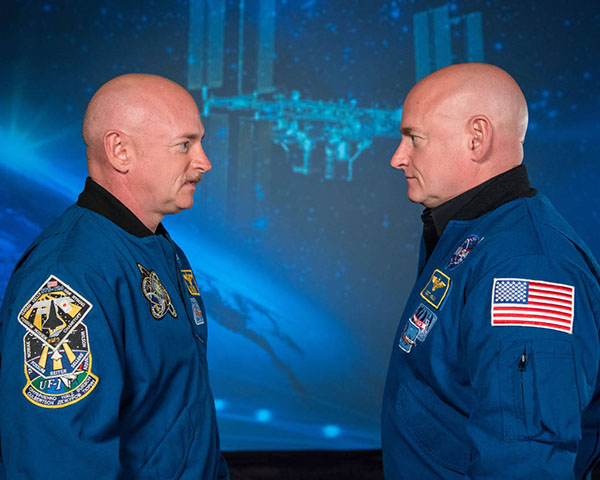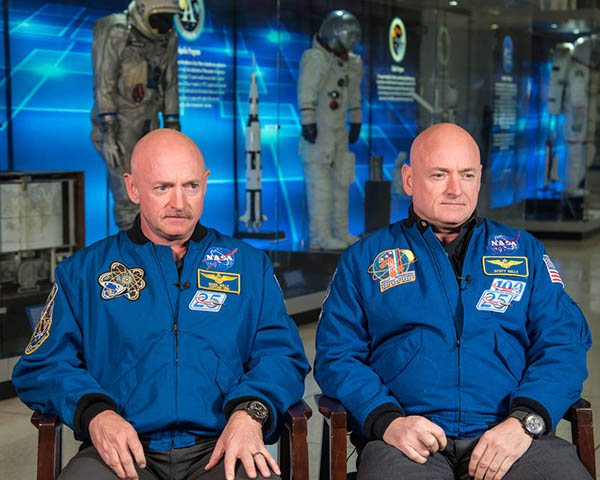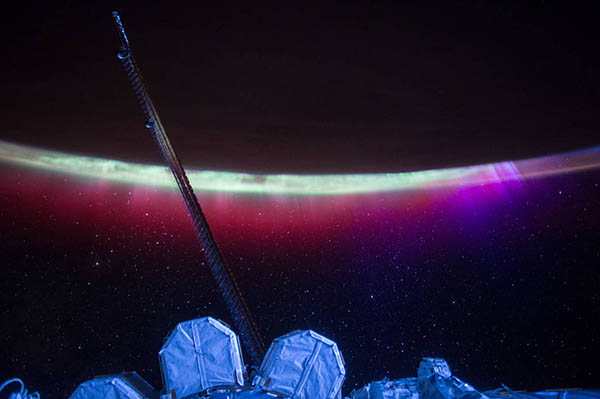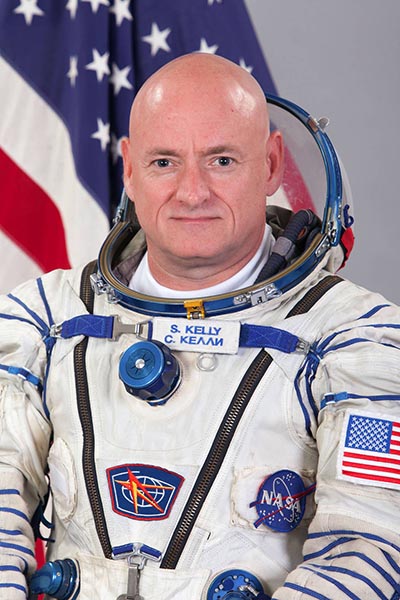
Expedition 45/46 Commander, Astronaut Scott Kelly along with his brother, former Astronaut Mark Kelly speak to news media outlets about Scott Kelly’s 1-year mission aboard the International Space Station. Photo Date: January 19, 2015. Location: Building 2. Photographer: Robert Markowitz
In March 2015, astronaut Scott Kelly embarked on a one-year stay aboard the International Space Station, while his identical twin brother Mark Kelly, a retired astronaut, remained on planet Earth. This remarkable event—accompanied by a frenzy of media attention—created a degree of separation between twins that scientists could previously only imagine. For science journalists and their readers, the Kelly twin astronauts were like a dream come true, a perfect marriage between popular fascination with twins and Americans’ boundless enthusiasm for space travel. Attention-grabbing headlines like “Meet the twins unlocking the secrets of space”, “Nature vs. Nurture vs. NASA”, and “NASA twins to embark on year-long space experiment” began to appear in the news. Friends and colleagues were quick to forward these stories to me, knowing of my personal (I’m an identical twin) and professional (I’m an anthropologist who studies twin researchers) interest in twins. Scientific research on twins has a long history, so as I read about the plans for experimentation on the Kelly twins, there was much that was familiar to me. In a way, the twin-in-space and twin-on-earth scenario is a logical conclusion of long-standing scientific fantasies about twins and their power to reveal the hidden workings of nature and nurture. Interestingly, however, by the time it became possible to realize this older vision of twin research, the life sciences had entered the molecular era, with new methodologies and technologies threatening to replace the classical twin study. So, we might ask—how did we end up with this improbable study of twin astronauts?
Twins in Science

Image: Scott and Mark Kelly speaking to the media. Source: NASA.
Twins have appeared in science in many guises—as thought experiments, as experimental subjects. Space scientists have been thinking about twins for quite a while. The “twin paradox,” a thought experiment familiar to those who have studied physics (and a bit convoluted for those who have not) describes a situation in which one twin departs the planet for a long-distance space trip while the other twin stays behind. According to the theory of special relativity, which deals with motion and the passage of time, when the space twin returns to earth, he or she will be younger than the earth twin. Paradoxically, however, the earth twin will perceive the space twin as the older one.[1] While the twin paradox is often attributed to Albert Einstein, he did not actually write about twins. His thought experiment featured clocks, one stationary, and the other traveling through space. Paul Langevin, a French physicist, reimagined the scenario in 1911 with twins instead of clocks, creating a more provocative and memorable illustration of Einstein’s theory and providing seemingly endless fodder for scientific debate (Chang 1993:745-746).
Physicists, of course, haven’t been the only scientists interested in twins. The eugenicist Francis Galton first proposed using twins to study “the relative powers of nature and nurture” in 1875. Interestingly, Galton also likened twins to clocks, describing twins over their lifetimes “keeping time like two watches” and ruminating on how, with certain twins, “the clocks of their two lives move regularly on, and at the same rate, governed by their internal mechanism” (Galton 1875[1896]:402-403).I[2] After Galton, life scientists, behavioral scientists, and medical researchers turned their attention to twins, setting up experiments and forming twin registries and databases to investigate and keep track of these intriguing pairs of siblings. Today, we take it as a given that twins constitute a “natural experiment” and that their lives and biologies offer valuable scientific evidence about genetics, environments, and their interactions.

Image: A photograph taken by Scott Kelly from the International Space Station. Source: NASA.
In this sense, the researchers who responded to NASA’s call for proposals and whose projects were selected are not so different from the scientists I studied in Sweden, who use the Swedish Twin Registry to study the influence of genes and environments on human health and behavior. The researchers working with NASA also see twins as a unique tool for investigating problems that pertain to humans more generally. The ongoing research program with the Kelly twins focuses on the relationship between the spaceflight environment and physiological function; cognitive performance; and the epigenome, proteome, baceteriome, and proteome. If you remove the word “spaceflight,” these are not unusual research areas in contemporary twin studies. However, the Kelly twin experiment—described as NASA’s first integrated omics study—is drastically different from traditional research on twins, and not just because one twin will spend a year in space.
From the Classical Twin Method to the Omics Era

Image: Scott Kelly suited up. Source: NASA.
Twin studies have varied in methodology, but traditionally, large sample sizes of both identical (monozygotic) and fraternal (dizygotic) twins were compared with regard to a trait, disease, or behavior. Because identical twins are understood to share 100% of their genome, while fraternal twins share about 50% of their segregating genetic material, concordances for the given trait, disease, or behavior are computed separately for the two kinds of twins, and if the concordance for the trait was higher for the identical twins than the fraternal twins, “genetic influences are indicated” (Lichenstein et al. 2002:190). Research based on only one set of identical twins would thus seem to have little in common with the classical twin study model, as the comparison between fraternal and identical twins that has been the basis of most twin research is not possible. The sample size of two individuals is also a departure from traditional practice. However, with the development of the “omics”—e.g., genomics, proteomics, metabolomics—in biology, attention has increasingly shifted to the molecular level. The quantitative genetic logic of classic twin studies—compare and compute—has taken a back seat to newer approaches, like those currently underway with the Kelly twins, which rely on whole-genome sequencing and bioinformatics. Twin researchers and those responsible for twin registries are rapidly moving into the omics era by combining existing twin data with DNA samples and finding new ways to use twins for large-scale molecular studies (Strachan et al. 2012; van Dongen et al. 2012).
Amid the sea change in technologies and methodologies in biology, the key role of twins as research subjects appears to remain constant. The identification between twins and research first proposed by Galton has now become second nature: the Kelly twins, perhaps recalling the twin paradox from a physics course or the twin study method from a biology class, were the ones to propose the study to NASA. As NASA’s call for proposals notes: “This opportunity originated at the initiative of the twin astronauts themselves.” The Kelly twins’ recognition of themselves as perfect research subjects suggests how far the relationship between science and twins has come. Scientific fantasies about twins in space and human clocks have become realities as twins dutifully accept, even celebrate the significance of their lives and bodies for science. However, life science in the omics era is posing new challenges to old ideas about nature and nurture. The idea of a bright-line distinction between nature and nurture which made twins seem like an ideal tool for dividing the two is no longer ascendant. Yet is seems that there is still a place for twins in science (and a place for twins in space), even if the logic that holds them there is not as clear as it once was.
Notes
[1] For a more detailed explanation of the twin paradox and special relativity, see Markus Pössel 2010. The case of the traveling twins. Einstein Online 4: 1007. http://www.einstein-online.info/spotlights/Twins
[2] For a discussion of Galton’s work on twins, see Alison Cool 2014. Twins, nature and nurture. BioSocieties 9.2: 225-227
Works Cited
Chang, Hasok. 1993. A misunderstood rebellion: The twin-paradox controversy and Herbert Dingle’s vision of science. Studies in History and Philosophy of Science Part A 24.5:741-790.
Galton, Francis. 1875. The history of twins, as a criterion of the relative powers of nature and nurture. Fraser’s Magazine 12, pp. 566–576. Quoted from the reprint in: Journal of the Anthropological Institute of Great Britain and Ireland 5, 1896, pp. 391–406.
Lichtenstein, P; De faire, U; Floderus, B; Svartengren, M; Svedberg, P.; and Pedersen, N. 2002. The Swedish Twin Registry: a unique resource for clinical, epidemiological and genetic studies” Journal of Internal Medicine 252(3):184-205.
Strachan, Eric, Corinne Hunt, Niloofar Afari, Glen Duncan, Carolyn Noonan, Ellen Schur, Nathaniel Watson, Jack Goldberg, and Dedra Buchwald. 2012. University of Washington Twin Registry: Poised for the Next Generation of Twin Research. Twin Research and Human Genetics 16.1:455-462.
Van Dongen, Jenny, P. Eline Slagboom, Harmen H.M. Draisma, Nicholas G. Martin, and Dorret I. Boomsma. 2012. The continuing value of twin studies in the omics era. Nature Reviews Genetics 13:640-653.
Alison Cool is an assistant professor of anthropology at the University of Colorado Boulder. Her work focuses on medical anthropology and the anthropology of science and technology, and her primary research interests concern the relationships between genetic and economic approaches to behavior and the politics of the Swedish welfare state. More broadly, her research interests include Scandinavia; science policy; expertise; economics; life sciences; twin studies; global data circulation; and cultural understandings of privacy and surveillance.

1 Comment
SRT is completely erroneous since it is based on the wrong kind of transformations: they have lost the scale factor characterizing the Doppler effect. First, Lorentz considered a more general form of transformations (with a scale factor), but then he, and also Poincare and Einstein equated it 1 without proper grounds. Their form was artificially narrowed, the formulas became incorrect. This led to a logical contradiction of the theory, to unsolvable paradoxes. Accordingly, GRT is also incorrect.
For more details, see my brochure “Memoir on the Theory of Relativity and Unified Field Theory” (2000):
http://vixra.org/abs/1802.0136
1 Trackback